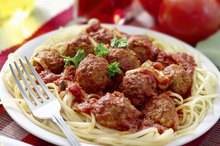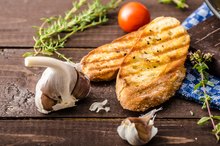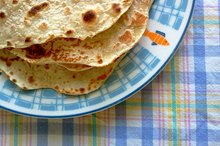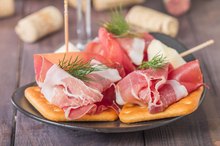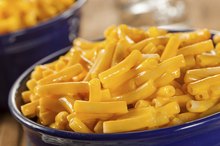What does fact checked mean?
At Healthfully, we strive to deliver objective content that is accurate and up-to-date. Our team periodically reviews articles in order to ensure content quality. The sources cited below consist of evidence from peer-reviewed journals, prominent medical organizations, academic associations, and government data.
- Weight-control Information Network; Weight Loss and Nutrition Myths; March 2009
- MayoClinic.com; Energy Density and Weight Loss; Jan. 2011
- Linus Pauling Institute; Glycemic Index and Glycemic Load; Feb. 2009
The information contained on this site is for informational purposes only, and should not be used as a substitute for the advice of a professional health care provider. Please check with the appropriate physician regarding health questions and concerns. Although we strive to deliver accurate and up-to-date information, no guarantee to that effect is made.
Does Pumpernickel Bread Make You Fat?
Over 190 million Americans are overweight, accounting for two-thirds of the United States population, according to a January 2010 CBS News report. If you are among them, learning which foods have beneficial or detrimental effects on your weight may inspire you to make wise choices. Pumpernickel bread, a dark, heavy subtly-sweet bread derived from Germany, can suit a weight loss-friendly diet if you approach it properly. For best weight management results, seek guidance from your doctor or dietitian.
Myths
Pumpernickel, like all breads, is a starchy food. A common misbelief, according to the Weight-control Information Network, is that starchy foods are fattening and you should avoid them during the weight loss process. Many starch-rich foods are low in fat and calories, however, and valuable sources of nutrients. They also provide energy for your body.
- Pumpernickel, like all breads, is a starchy food.
- A common misbelief, according to the Weight-control Information Network, is that starchy foods are fattening and you should avoid them during the weight loss process.
Benefits
The Calories in Meatballs
Learn More
Traditional pumpernickel bread is a whole grain bread made with coarse rye meal and rye flour. As fiber-rich foods, whole grains allow you to feel fuller on fewer calories and stay fuller longer between meals. Pumpernickel bread also has a low glycemic index, or impact on your blood sugar 3. Low-glycemic foods also promote appetite control and may guard against overeating, type 2 diabetes and obesity. One slice of pumpernickel bread contains about 80 calories -- the amount found in an apple -- 2.1 g of fiber and 3 g of protein.
- Traditional pumpernickel bread is a whole grain bread made with coarse rye meal and rye flour.
- Low-glycemic foods also promote appetite control and may guard against overeating, type 2 diabetes and obesity.
Risks
Overeating any food can trigger weight gain. And preparing breads and other starches with high-fat ingredients, such as butter, can add hefty amounts of unhealthy fat and calories, making it difficult to stay within your caloric needs. Because breads vary significantly in ingredients, one loaf of pumpernickel bread may contain primarily whole grains and rich amounts of nutrients, while a nearby brand is based on refined grains, such as wheat flour. Refined grain products tend to have a higher glycemic impact and less fiber 3.
- Overeating any food can trigger weight gain.
- Because breads vary significantly in ingredients, one loaf of pumpernickel bread may contain primarily whole grains and rich amounts of nutrients, while a nearby brand is based on refined grains, such as wheat flour.
Suggestions
Calories in Panini Bread
Learn More
Rather than severely restrict carbohydrates, starchy foods or calories, you should aim for gradual, steady weight loss through a balanced, nutritious diet. Healthy diets emphasize vegetables, fruits, whole grains, lean protein sources, such as:
- nuts
- seeds
Limit refined grains and foods high in sodium, added sugars, cholesterol and unhealthy fat. If you enjoy pumpernickel bread, select varieties based on whole grains and stick to reasonable portion sizes, such as 1 to 2 slices as part of a balanced meal. Rather than top bread with cheese, mayonnaise or butter, use trace amounts of olive oil, a heart-healthy fat source, or low-calorie toppings, such as
- tomatoes
- spinach
- sprouts
- mustard
- Rather than severely restrict carbohydrates, starchy foods or calories, you should aim for gradual, steady weight loss through a balanced, nutritious diet.
- If you enjoy pumpernickel bread, select varieties based on whole grains and stick to reasonable portion sizes, such as 1 to 2 slices as part of a balanced meal.
Related Articles
References
- CBS News: Battling Obesity
- MayoClinic.com; Energy Density and Weight Loss; Jan. 2011
- Linus Pauling Institute; Glycemic Index and Glycemic Load; Feb. 2009
- Bread, pumpernickel. FoodData Central. U.S. Department of Agriculture. Published April 1, 2020.
- Rye kernel (Pumpernickel) bread. University of Sydney GI Database. Updated November 26, 2019.
- National Institutes of Health Office of Dietary Supplements. Manganese: Fact sheet for consumers. Updated October 8, 2019.
- National Institutes of Health Office of Dietary Supplements. Selenium: Fact sheet for consumers. Updated December 10, 2019.
- National Center for Complimentary and Integrative Health. Antioxidants: In depth. Updated November 2013.
- Adlercreutz H. Can rye intake decrease risk of human breast cancer?. Food Nutr Res. 2010;54:10.3402/fnr.v54i0.5231. doi:10.3402/fnr.v54i0.5231
- Jonnalagadda SS, Harnack L, Liu RH, et al. Putting the whole grain puzzle together: health benefits associated with whole grains--summary of American Society for Nutrition 2010 Satellite Symposium. J Nutr. 2011;141(5):1011S‐22S. doi:10.3945/jn.110.132944
- Holma R, Hongisto SM, Saxelin M, Korpela R. Constipation is relieved more by rye bread than wheat bread or laxatives without increased adverse gastrointestinal effects. J Nutr. 2010;140(3):534-41. doi:10.3945/jn.109.118570
- Bread, white. FoodData Central. U.S. Department of Agriculture. Published April 1, 2020.
- Miketinas DC, Bray GA, Beyl RA, Ryan DH, Sacks FM, Champagne CM. Fiber intake predicts weight loss and dietary adherence in adults consuming calorie-restricted diets: The POUNDS lost (preventing overweight using novel dietary strategies) study. J Nutr. 2019;149(10):1742‐1748. doi:10.1093/jn/nxz117
- Jenkins DJ, Wolever TM, Jenkins AL, et al. Low glycemic response to traditionally processed wheat and rye products: bulgur and pumpernickel bread. Am J Clin Nutr. 1986;43(4):516-20. doi:10.1093/ajcn/43.4.516
- Breen C, Ryan M, Gibney MJ, Corrigan M, O'shea D. Glycemic, insulinemic, and appetite responses of patients with type 2 diabetes to commonly consumed breads. Diabetes Educ. 2013;39(3):376-86. doi:10.1177/0145721713479675
- Letrán A, Palacín A, Barranco P, Salcedo G, Pascual C, Quirce S. Rye flour allergens: an emerging role in baker's asthma. Am J Ind Med. 2008;51(5):324-8. doi:10.1002/ajim.20566
- American Academy of Allergy, Asthma, and Immunology. Celiac disease, non-celiac gluten sensitivity, and food allergy: how are they different?.
- American Academy of Allergy, Asthma, and Immunology. Gluten intolerance definition.
Resources
Writer Bio
August McLaughlin is a certified nutritionist and health writer with more than nine years of professional experience. Her work has been featured in various magazines such as "Healthy Aging," "CitySmart," "IAmThatGirl" and "ULM." She holds specializations in eating disorders, healthy weight management and sports nutrition. She is currently completing her second cookbook and Weight Limit—a series of body image/nutrition-related PSAs.
